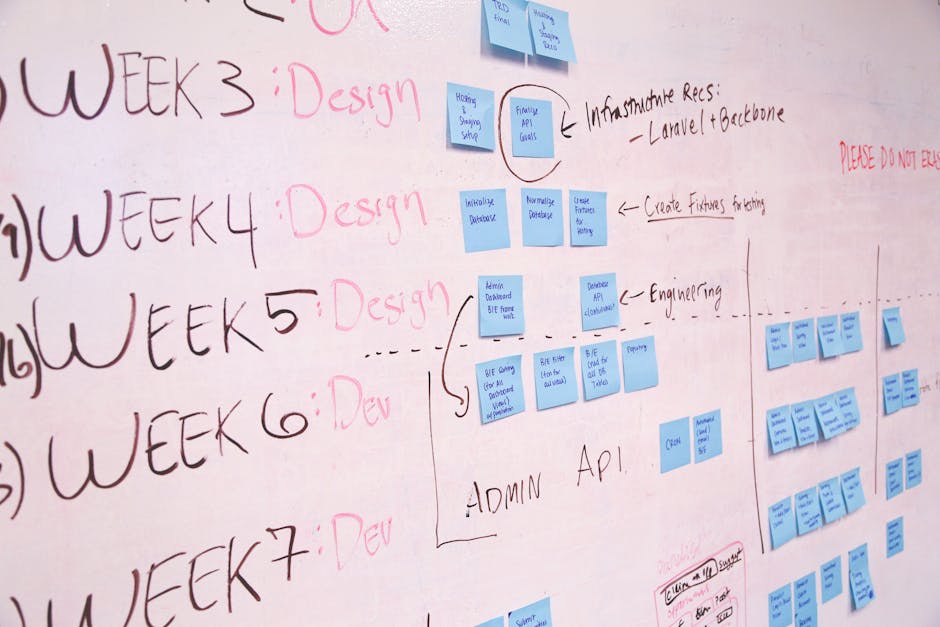What Defines a Lean MVP for SaaS Start-ups?
So, you think you’ve got a revolutionary SaaS start-up idea, huh?
Well, before you dive headfirst into development, let’s talk about what defines a lean MVP for SaaS start-ups. You might be surprised to learn that it’s not just about throwing together a basic version of your product and hoping for the best.
In fact, defining a lean MVP involves a strategic approach that focuses on identifying the core problem, defining essential features, building a minimal prototype, and testing and iterating before launching.
But what exactly does that look like in practise? Stick around to uncover the key elements of a lean MVP that can set your SaaS start-up up for success.
Key Takeaways
- Lean MVPs for SaaS start-ups focus on rapidly testing and iterating ideas to create maximum value for customers while minimising waste and inefficiency.
- The core problem should be validated using data-driven techniques, narrowing down to address customers’ pain points and prioritising based on their impact on the target market.
- Problem validation techniques include engaging directly with potential customers, conducting interviews and surveys, leveraging market research and competitor analysis, and iteratively refining and validating the core problem.
- Essential features for a Lean MVP should prioritise addressing customers’ pain points, gathering qualitative and quantitative data to understand user behaviour, iterating based on user feedback, and defining features based on user preferences and proven design principles.
Understanding Lean Start-up Methodology

To successfully implement lean start-up methodology, you need to focus on rapidly testing and iterating your ideas to create maximum value for your customers while minimising waste and inefficiency. This approach is crucial for identifying your early market and achieving product-market fit. By focussing on the early market, you can gather valuable insights and feedback to shape your product according to the needs and preferences of your initial customers.
This customer-centric approach allows you to create a product that resonates deeply with your target audience, increasing the likelihood of achieving product-market fit.
Data-driven decision-making is at the core of lean start-up methodology. By collecting and analysing data from your early market, you can gain a deeper understanding of your customers’ behaviours, preferences, and pain points. This iterative process enables you to continuously refine your product to better meet the needs of your target audience, ultimately driving towards achieving product-market fit.
Identifying the Core Problem

Let’s start by analysing the core problem that your customers are facing. Use data-driven techniques to validate the problem and ensure that it alines with your target market’s needs.
This iterative approach will help you narrow down the core problem and build a solution that truly addresses your customers’ pain points.
Core Problem Analysis
By identifying the core problem that your customers are facing, you can lay the foundation for a data-driven and customer-centric approach to developing your MVP for SaaS start-ups. To achieve this, consider the following:
-
Problem Prioritisation: Prioritise the core problems based on their impact on the target market. This will help in focussing your efforts on solving the most critical issues first.
-
Utilise data from market segmentation to identify which customer segments are most affected by the core problems. This will enable you to tailor your MVP to meet the specific needs of these segments.
Problem Validation Techniques
Identify the core problem by engaging directly with your potential customers to validate their pain points and prioritise the most pressing issues for your SaaS start-up MVP development. Conduct customer interviews and surveys to gather firsthand insights into their challenges and needs.
This customer-centric approach ensures that your MVP addresses real problems faced by your target audience. Additionally, leverage market research and competitor analysis to gain a comprehensive understanding of the industry landscape. Analyse existing solutions and identify gaps that your SaaS start-up can fill.
By integrating data-driven decision-making into the problem validation process, you can iteratively refine and validate the core problem to ensure that your MVP effectively addresses the most critical pain points.
This approach empowers you to develop a solution that truly resonates with your customers.
Defining Essential Features

You want to focus on core functionality, user experience, and value proposition when defining essential features for your SaaS start-up.
By prioritising these key elements, you can ensure that your product addresses the fundamental needs of your target users while delivering a compelling and differentiated experience.
This customer-centric approach, backed by data-driven insights and an iterative mindset, will enable you to build a lean MVP that resonates with your audience and sets the stage for future growth.
Core Functionality
When developing the core functionality for your SaaS start-up, prioritise features that directly address the most pressing pain points of your target customers. By focussing on user engagement, you can ensure that your core features are alined with what your customers truly need. Consider the following:
- User-Centric Approach
- Gather qualitative and quantitative data to understand user behaviour and preferences.
- Iterate based on user feedback to continuously improve the core functionality.
Understanding the core functionality from the perspective of your users empowers you to create a product that resonates with their needs and desires. This approach fosters a sense of freedom for your customers, as they’re actively involved in shaping the product to better serve them.
User Experience
As you continue refining the core functionality to address your customers’ pain points, the next step is to define the essential features that will contribute to a seamless user experience. User feedback should be at the forefront of this process.
Gather insights from your target audience to understand their preferences, pain points, and behaviours. Incorporate these insights into the design principles of your SaaS product. By iterating based on user feedback and alining with proven design principles, you can ensure that the essential features aren’t only functional but also intuitive and user-friendly.
Value Proposition
To define the essential features of your SaaS product’s value proposition, prioritise customer-centric, data-driven insights and iterative refinement for optimal functionality and user satisfaction. Consider the following steps:
-
Defining Customer: Conduct in-depth market research to understand your target audience’s needs and pain points. Utilise customer feedback and behaviour analysis to shape your value proposition.
-
Satisfaction Metrics: Implement satisfaction metrics such as Net Promoter Score (NPS) and Customer Satisfaction (CSAT) to quantitatively measure user satisfaction and identify areas for improvement.
-
Competitive Analysis: Analyse competitors’ value propositions to identify gaps and opportunities. Leverage this insight to differentiate your offering and provide unique value to your customers.
Building a Minimal Prototype

Start by identifying the essential features that directly address your target customers’ pain points and provide the most value. Embrace minimal design and rapid iteration to create a prototype that resonates with your audience. Focus on the core functionalities that solve their problems and deliver a seamless user experience. Below is a sample framework to help you prioritise the features for your minimal prototype:
| Pain Point | Essential Feature | Value Provided |
|---|---|---|
| Inefficient Task Management | Task Prioritisation | Time-saving and productivity improvement |
| Complex Reporting | Simplified Analytics | Clear insights and ease of decision-making |
| Lack of Collaboration | Real-time Collaboration | Enhanced teamwork and communication |
| Cumbersome Onboarding | Guided Onboarding | Quick user adoption and reduced churn |
| Data Security Concerns | Robust Security Measures | Trust and peace of mind for users |
Testing and Iterating

After identifying the essential features for your minimal prototype, it’s time to validate their effectiveness through rigorous testing and iteration, ensuring that each iteration brings you closer to delivering maximum value to your customers.
Here’s how you can approach this crucial phase:
- Testing Techniques
- Utilise A/B testing to compare different versions of your product and determine which resonates best with your customers.
- Implement useability testing to gather direct feedback from users on how they interact with your product, allowing you to make informed improvements.
By employing these testing techniques, you can gather valuable insights into how your customers engage with your SaaS solution, enabling you to refine and enhance its functionality based on real user experiences.
- Iterative Process
- Embrace an agile approach, constantly refining and evolving your product based on customer feedback and market demands.
- Regularly analyse data and metrics to identify areas for improvement, allowing you to make data-driven decisions and adapt your SaaS solution to meet evolving customer needs.
Launching the MVP

When launching your MVP, focus on delivering a streamlined and impactful experience that addresses your customers’ core needs while setting the stage for iterative enhancement based on real-world usage. Start by conducting MVP testing to gather valuable insights from real users. This data-driven approach will help you understand how well your MVP meets customer needs and identify areas for improvement.
By prioritising customer-centricity, you can ensure that your MVP resonates with your target audience and provides real value.
As you prepare to launch, keep in mind that achieving product-market fit is an ongoing process. Your MVP is the initial step in this journey, allowing you to gather essential feedback and iterate based on real-world usage. Embrace the freedom to adapt and evolve your MVP in response to market dynamics and user feedback. This iterative approach will enable you to refine your product and enhance its fit within the market.
Frequently Asked Questions
How Can Saas Start-ups Effectively Measure the Success of Their MVP Once It’s Launched?
Once launched, you’ll measure MVP success by tracking user engagement and retention. Analyse performance metrics and utilise analytics to gain insights. Iterate based on data and customer feedback, continuously improving to achieve your goals.
What Are Some Common Pitfalls to Avoid When Building a Minimal Prototype for a Saas Start-up?
When building a minimal prototype for your SaaS start-up, common mistakes to avoid include skipping product validation, neglecting iterative development, and overlooking user engagement. Stay customer-centric, data-driven, and iterate for freedom and success.
How Can Saas Start-ups Gather and Incorporate User Feedback During the Testing and Iterating Phase?
So, you want to gather user feedback for your SaaS start-up, huh? Engage users through surveys, interviews, and user testing. Incorporate feedback into your iterative testing process to create a customer-centric, data-driven product.
What Are Some Key Strategies for Effectively Marketing and Promoting the Launch of a Saas Mvp?
When marketing and promoting the launch of your SaaS MVP, focus on social media promotion and influencer partnerships. Engage with your audience, gather data, and iterate your strategies to ensure maximum impact and freedom in reaching potential customers.
How Can Saas Start-ups Determine the Optimal Pricing Strategy for Their Mvp?
You need to determine the optimal pricing strategy for your SaaS MVP like a captain navigating through uncharted waters. Conduct competitive analysis and customer segmentation to uncover insights for your value proposition and revenue model.
Conclusion
Congratulations on taking the first steps towards building a successful SaaS start-up with a lean MVP.
Did you know that 74% of high-growth companies use lean start-up methodologies to guide their product development?
By focussing on the core problem, defining essential features, and testing and iterating, you’re setting yourself up for success in the competitive SaaS market.
Keep iterating and gathering data to ensure your MVP meets the needs of your customers.
Contact us to discuss our services now!